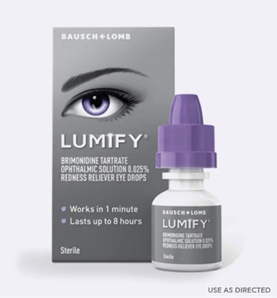In the ongoing saga of eye drop-related recalls and alerts, the U.S. Food and Drug Administration (FDA) has once again sounded the alarm, urging consumers to exercise caution and verify the authenticity of their eye drops. This latest warning adds to a series of recalls and alerts issued over the past year, emphasizing the persistence of the issue and the potential risks associated with counterfeit products infiltrating the market.
The FDA’s advisory specifically targets counterfeit eye drops that have surfaced in the U.S., mimicking the appearance of authentic Lumify artificial tears produced by Bausch + Lomb. These knockoff versions, not approved for use, present a significant risk of infection, irritation, or injury, prompting the FDA to raise awareness and caution consumers about their potential presence in the market.
The agency identified several counterfeit products attempting to replicate the appearance of Bausch + Lomb’s Lumify drops. The imitations, namely South Moon, Rebright, and FivFivGo, have packaging designed to closely resemble the authentic Lumify drops, featuring white lettering on a grey background and an image of an eye with a pale purple iris. Even the bottles inside the packaging mirror Lumify precisely, down to the purple cap and grey label with white lettering.
The deceptive similarity between the counterfeit and authentic products raises concerns about the ease with which consumers could mistake the knockoffs for the real thing. The FDA highlighted that the primary differences lie in the written content on the packaging, including bullet points explaining the product’s use and the brand name.
Importantly, the FDA stressed that South Moon, Rebright, and FivFivGo are not approved for sale in the U.S. Their misleading packaging falsely claims they can treat eye conditions such as glaucoma, a serious ailment that can only be addressed with prescription drugs or surgery.
Upon conducting an investigation, the FDA discovered that South Moon eye drops not only lacked brimonidine tartrate, the active ingredient in Lumify, but were also contaminated with Burkholderia cepacia complex bacteria. This type of contamination can lead to antibiotic-resistant infections, underscoring the potential dangers posed by these unauthorized and counterfeit products. While the FDA was unable to obtain samples of FivFivGo at the time of the warning, the agency remains vigilant in monitoring and addressing potential threats.
As of the FDA’s announcement, there were no specific reports of adverse reactions linked to South Moon, Rebright, or FivFivGo. However, reports of possibly fake Lumify causing eye irritation, pain, and infection have been received, prompting heightened concern about the broader impact of counterfeit eye drops on consumer health.
To assist consumers in differentiating between authentic and counterfeit products, the FDA emphasized key indicators to look for. Authentic Lumify is clearly labeled as such, produced by Bausch + Lomb, and includes a list of ingredients, with brimonidine tartrate identified as the active component. Some copycat products may falsely bear the label “Bausch + Lomb” at the top of the packaging, resembling authentic labeling.
Consumers are urged to exercise caution and purchase eye drops from reputable retailers, such as state-licensed pharmacies, to mitigate the risk of encountering counterfeit products. Online shoppers are particularly encouraged to be vigilant and verify the authenticity of the products they purchase.
In the event of uncertainty or suspicion regarding the authenticity of eye drops, the FDA advises disposal. Those who may have already used a counterfeit product are strongly encouraged to consult with their healthcare provider and seek immediate medical attention if any signs of infection or adverse reactions manifest.
As the FDA delves into the origin of these counterfeit products, it underscores the importance of maintaining vigilance, raising awareness, and fostering a collaborative effort between regulatory authorities, healthcare professionals, and consumers to ensure the safety and integrity of products entering the market. The persistence of these warnings serves as a stark reminder of the potential hazards posed by counterfeit pharmaceuticals and the ongoing need for robust regulatory measures to protect public health.
